by: Bianca Perla, featured photo above by Kelly Keenan.
Have you ever touched whale skin? It’s slippery and firm like the smooth skin of a wet apple. Have you had the chance to stand and look down into a whale’s gaping mouth? The lines of stiff baleen fray open to reveal a thick purple tongue the size of a full grown human. If you were at Spring Beach Park last week you may have been one of the lucky ones to stumble upon a leviathan of the deep–a fin whale that met an early demise. Fin whales are federally endangered baleen whales that strain mostly fish and krill through their fibrous mouths. They are the second largest whale species in the world.
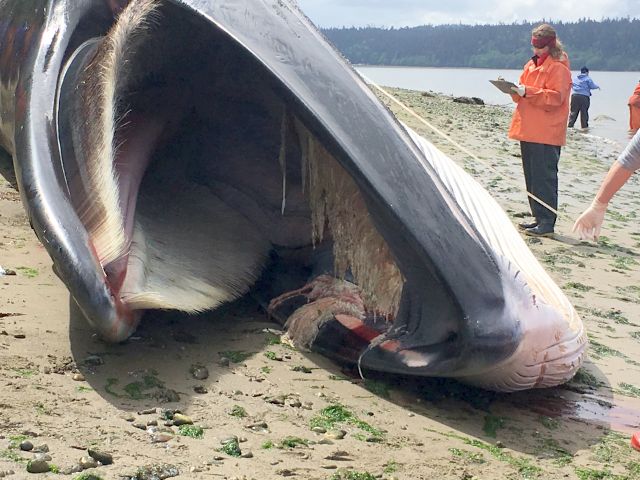
A view into a fin whale’s mouth. If you look closely you can see the tongue folded to the side against the back. Some baleen had been removed from this whale’s mouth which is a federal offense. All marine mammals are protected by law. Observing the animal is fine. But, no part of the animal can be removed. Photo by: Bianca Perla
It is transporting to walk carefully around an animal as massive as this with a presence so strong even in death. This whale, I discovered, was male. I imagined the world he came from, the mystery of those liquid realms he glided through. He saw places I can hardly imagine and explored depths, sights, and sounds that I will never understand.
I stopped at his eye, closed in death and larger than a human’s head, and wondered with a sharp sadness what it would have looked like gazing at me, open and alive.
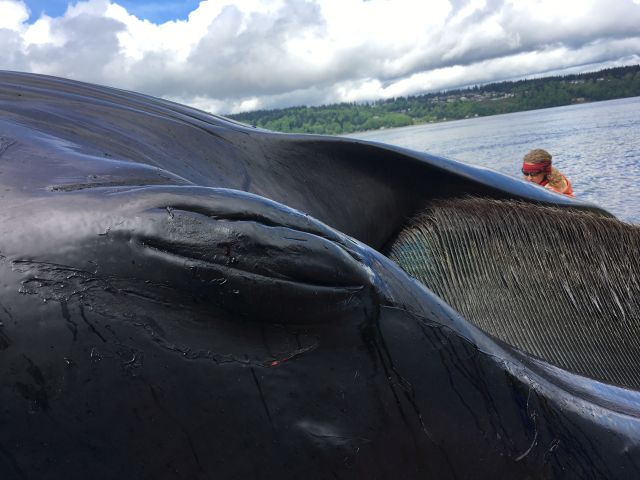
Eye of the fin whale, baleen mouth, and person for scale. Fin whales are our second largest whale species, only blue whales are larger. Photo by: Bianca Perla
This whale had been brought to our shores for an unfortunate reason. He had been found stuck to the bow of a tanker pulling into Commencement Bay in Tacoma. Needing to act fast, the Marine Mammal Stranding Network–spearheaded by NOAA and encompassing a dizzying array of research and response groups from all over the Puget Sound, brought this whale briefly to our island shores. (Other groups present to learn from the whale were: Cascadia Research Collective, SR3, Washington Department of Fish and Wildlife, MaST, University of Washington. From Vashon-Maury there were representatives from Sound Action and Vashon Nature Center).
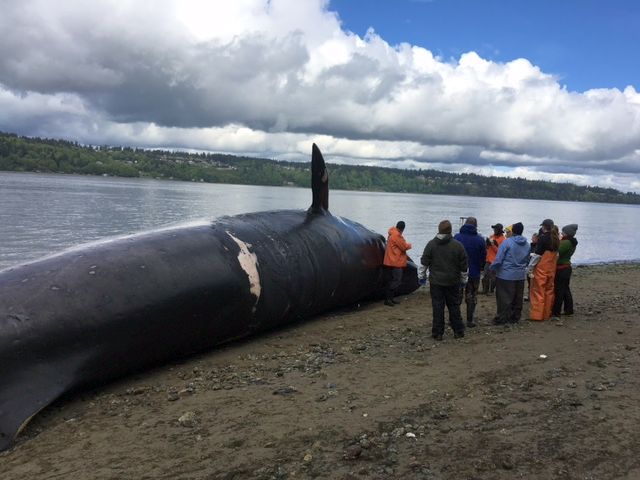
Network researchers prepare to start the necropsy. The white gash in the whale’s back is the impact site where the whale was hit by the tanker. Photo by: Bianca Perla.
Why was it necessary to drag this 52-foot long, approximately 70 ton, whale to land? To conduct a necropsy that would answer whether the whale was sick or healthy, alive or dead at the time of impact. In addition, this necropsy provides valuable information about typical characteristics of this endangered species including length, girth, parasite load, diet, genetics, contaminants, biotoxins and more. Researchers from the University of Washington even collected tissues to help with stem cell research!
Soon after the investigation began, some of the essential questions were answered. Blood spilled like a fountain when researchers cut into the impact site, indicating that the whale’s circulatory system had been working at the time of the strike. He had been alive when he was hit. Furthermore, oily blubber stores, a belly full of krill, and a low parasite load indicated that he had been a healthy juvenile. The case has now been turned over to federal law enforcement officers who will determine if the company that owns the tanker that hit this endangered whale will be deemed liable.
The arrival of this fin whale is harbinger of a larger change throughout Puget Sound. Released from the pressure of large scale whaling operations, these impressive sea mammals are making a comeback. This is great news but their increasing numbers also highlight threats to whale health still present in Puget Sound. According to NOAA, since 2015 we’ve had 4 humpback whale strandings in Puget Sound. Before 2015, we had zero. Not particularly frequent in the Puget Sound, fin whales seem particularly susceptible to boat strikes. Since 2002, there have been 12 fin whale deaths recorded in the Pacific Northwest, 10 of these from boat impact.
Talking to researchers on the beach I learned that this fin whale was the third whale stranding in our region in the last 10 days (the other 2 were gray whales– one a calf caught in derelict crab gear, and a mature female in poor nutritional condition. Another gray whale (22) was struck by a boat, but she survived and is healthy and well.) These necropsy crews have had almost no down time. Which brings up a final challenge: What do you do with dead whales?
The preferred option is to leave whales on the beach to decompose, as would happen if they died naturally and floated to shore. Their carcasses provide an abundant food source to wildlife of all types. Other options include sinking or burying them–both much less ecologically beneficial and also incredibly tricky. In some areas, the law does not allow the sinking of whales, and the permitting process for sinking or burying (can you imagine burying a 52-foot-long, six foot tall carcass???) are extremely complex and time consuming.
However, sometimes leaving the whales on the beach is not an easy task either. Very few people are thrilled about having a whale decompose on their beach, even if that beach is a public park. After complaints from a few Spring Beach residents, NOAA worked hard to find a more remote place on our island shores where the whale could be relocated. Although we have many long stretches of uninhabited shoreline, no willing land managers or private land owners, besides the original Vashon Park District owned site (thank you VPD!) came through.
After much discussion, the network did find a solution that would keep the carcass on a beach. At the expense of the tanker company that hit him, the fin whale was towed, at high tide, at midnight, to rest on McNeil Island, where there is no public or research access.
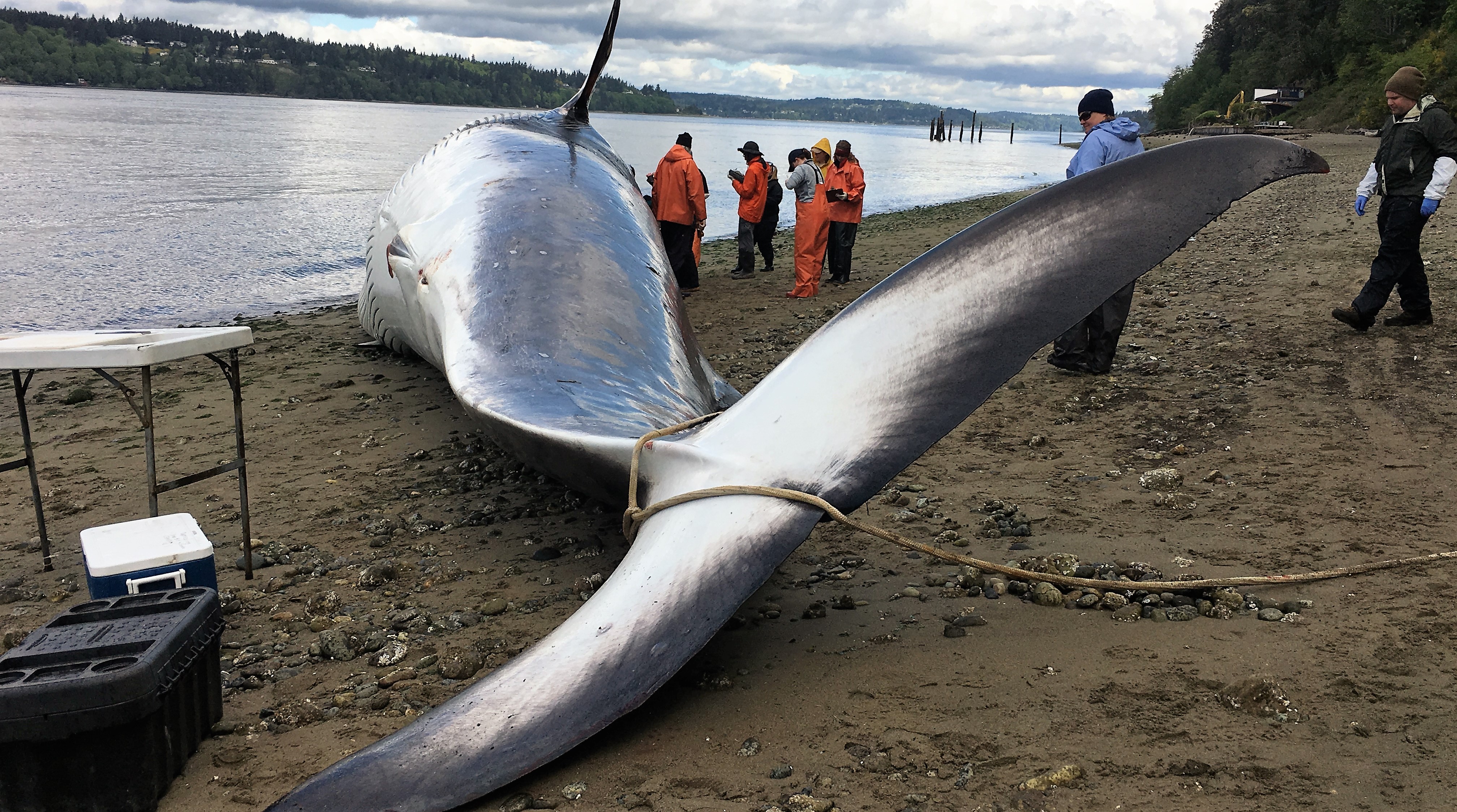
Seeing a marine mammal this size is an amazing experience! Photo by: Bianca Perla.
The chance to see a dead whale up close is a fascinating experience that many islanders would enjoy. In addition, following a whale carcass through all stages of decomposition could be an incredible scientific and educational endeavor for the whole community. Before we learned the whale was to be moved, Vashon Nature Center initiated conversations with the network about mounting a wildlife camera or webcam to document the wildlife that made use of the whale throughout the decomposition process. Whales have been absent from the Puget Sound for so long we have virtually no understanding of their potential influence on the Puget Sound ecosystem, even in their death.
We view this a big missed opportunity–for scientists, the local community, schools, and park visitors. There was not much time to make decisions and the concept new to land managers. Locally, the understanding of accompanying un-pleasantries (smell, sight, extra people on the beach) outweighed the understanding of benefits (scientific knowledge, unique experience, education, wildlife and ecosystem benefits from decomposition). The positive outcome is that we are now talking about places around Vashon and Maury that might be more palatable to put a stranded whale. This is a conversation that needs to happen. As NOAA stranding network coordinator Kristin Wilkinson aptly states, “The strandings are only going to increase and this is going to come up time and time again.”
As the whales return, we hope to lessen the negative impacts they experience in our waters. But, when a whale does die, will our community be able to find a space for these magnificent animals to cycle back to earth and sea naturally? To be carried in the stomachs of seagulls, in the nibbles of fish, in the talons of eagles, in the jaws of coyotes? We hope so, even if it’s a bit unpleasant and stinky.
More information: Marine mammal stranding network, Cascadia Research Collective autopsy report, SR3.
To report dead, injured or stranded marine mammals call our local marine mammal stranding coordinator or one of the above groups: Anne Stateler, 206-463-9041 or vashonorcas@aol.com.
Please note: Public access to Spring Beach Park is by water only. There is no public land access and the whale is now gone.

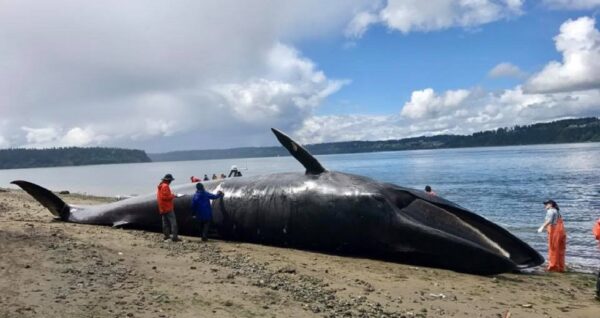
What do you do with a dead whale? Many years ago on a beach in Oregon, someone had the brilliant idea to dynamite a whale carcass into oblivion. Well, they dynamited the carcass and it blew up all over the place, and not in small pieces either. So, now instead of just one rotting thing, there were thousands of bits of decomposing whale all over everywhere! I think this was around Newport, and probably in the early 1970s, but I really can’t remember. I’m sure one could find this in some archives online for more information.
Oh my! What a story! Thanks Katie!